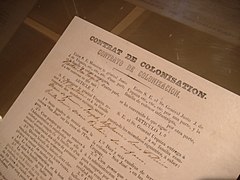This article includes alist of references,related reading,orexternal links,but its sources remain unclear because it lacksinline citations.(April 2024) |
Agricultural colonies in Argentinawere a demographically and economically important part of the evolution of the country. TheArgentinegovernment, faced with large areas of fertile land that were unpopulated or settled by aboriginal tribes (unassimilated and considered undesirable for progress), encouragedEuropeanimmigration,welcoming settling agreements with countries, regions and associations abroad.

Starting in 1853, PresidentJusto José de Urquizaencouraged the establishment of agricultural colonies in the Littoral region (westernMesopotamiaand north-easternPampas,the area of influence of theParanáandUruguayrivers). The national government signed a contract with an agency led by entrepreneurAarón Castellanos.
The first immigrants brought by this colonization contract arrived inRosario,Santa Fe,on March 24, 1854. The first formally organized agricultural colony wasEsperanza, Santa Fe,formed by 200 families fromSwitzerland,Germany,France,Italy,BelgiumandLuxembourgwho arrived during January and February 1856.
The production potential of these colonies can be measured by the fact that, in 1874, Argentina had to import wheat, while by 1880 the agricultural colonies were enough to supply the country's internal needs, and at the end of the 19th century Argentina became a major exporter.[citation needed]
Jewish migration
editMany other immigrants wereJews,fleeingpogromsin Europe and sponsored byMaurice de Hirsch'sJewish Colonization Association;they were later termed "Jewish gauchos".
Starting in 1880, Argentine governments had a policy of massive immigration, and theliberaltendencies of theRocaadministration were instrumental in makingJewsfleeingpogromsin Europe feel welcome. The first such Jewish colony was Moïseville (now the village ofMoisés Ville,Santa Fe).
In the 1880s and 1890s,France's BaronMaurice de Hirschorganized a campaign to relocate two-thirds of Jews in theRussianEmpire. Argentina was publicized as a destination for Jews:Alberto Gerchunoff,a Russian Jew who migrated to Argentina, recalled seeing print articles about the Jewish migration to Argentina in Tulchin, Russia, in 1889. In 1891, Hirsch established theJewish Colonization Associationto coordinate the purchase of land to accommodate Jewish migrants (seeJewish gauchos).
The Jewish population in Argentina grew and prospered in the ensuing years (seeHistory of the Jews in Argentina).
Leon Pinsker,in his bookAutoemancipation(1882) andTheodor Herzl,in his bookThe Jewish State(Der Judenstaat), evaluated Argentina as a potential destination for the oppressed Jews of Eastern Europe.
Some sources maintain that Herzl proposed that the Argentina project be given priority over settlement inPalestine.
The Zionist records attest to the fact that Herzl did consider Argentina, as well aspresent-day Kenya,as alternatives to Palestine. Also,Israel Zangwilland hisJewish Territorialist Organization(ITO) split off from the main Zionist movement; theterritorialists' aim was to establish a Jewish homeland wherever possible. The ITO never gained wide support and was dissolved in 1925, leaving Palestine as the sole focus of Zionist aspirations.
References
edit- (in Spanish)Monografias.com.Historia Argentina - Período 1880–1916.
- (in Spanish)La inmigración italiana en Argentina.(Archived2009-10-24)